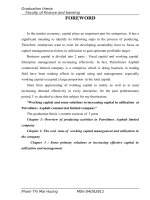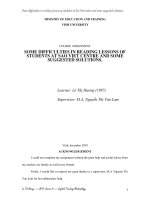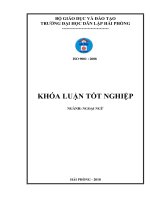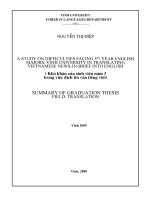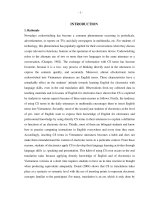SOME DIFFICULTIES AND REQUIRED SUGGESTIONS IN TRANSLATING NEWS STORY
Bạn đang xem bản rút gọn của tài liệu. Xem và tải ngay bản đầy đủ của tài liệu tại đây (225.22 KB, 27 trang )
SOME DIFFICULTIES AND REQUIRED SUGGESTIONS IN
TRANSLATING NEWS STORY
3.1 Some difficulties in translating news story
While Vietnam has gone through ‘renovation” to being a market economy,
the people of Vietnam have also gone through various stages, rushing and
elbowing their way through to learn an international language as a mean of
relating meaningfully to the wider world. This has created what could be could
‘English fever’. The government plans to popularize English until 2010 at
schools. Thus, Vietnamese learners of English tend to encounter a lot of
difficulties in their acquisition of the target language especially in press. In this
paper, I would like to mention about the barriers of culture and language for
Vietnamese to understand English news stories.
3.1.1 Cultural difficulty
Our culture provides the lens through which we view the world. It refers to
a group or community with which we share common experiences that shape the
way we understand the milieu in which we live. Culture is a kind of meta-
preference, in the sense it tells us what we should want to want. The term
‘culture’, is a complex concept which has been defined in numerous ways
often reflecting the writer’s academic orientation. Common to all definitions
of culture, however, is that culture is something shared by members of a
social group.
The system of language is a part of shared cultural knowledge of social
groups, and ways of communicating are an important part of the observable
behavior of people in social groups.
It is clear that there is climate close relationship between language and
culture. For example, thinking of the richness if vocabulary to take about
relations in languages spoken by people whose culture places a strong
emphasis on family ties, such as Pitjantjatjara, Burmeae or Vietnamese, to
Trinh Thi Ha – K11C 1
mention only a few. In fact, most linguists today would agree that it is
impossible to prove that language determines or only reflects the way we
think.
Some questions relating to language are raised that if there are any
concepts which can’t be translated or expressed in some other languages,
especially in press. Answering it briefly, it is clear that there are some
concepts which need many words to express into another language.
For example, the English word ‘baby-sister’ is central to western
cultures in which it is assumed that a baby or a child will from time to time be
left in the care of an individual who is not a member of the family, and who
undertakes to care for the baby or child usually in return for remuneration.
And it may be translated into Vietnamese as ‘cô trông trẻ’, ‘cô nuôi dạy trẻ’
or ‘vú em’…
It would be strange to Vietnamese if someone says [22]:
“… these which survive may live for twenty years and reach the size of a
dinner plate”.
Traditionally, Vietnamese might not know what a dinner palate is. We
always have meals with bowls and chopsticks and hardly know the size of a
dinner plate. Therefore, this group of words is a barrier preventing
Vietnamese reader from understanding the text.
In conclusion, language consists of a complex system of communication,
which enables people to construct the meanings needed to communicate with
each other. Culture is the whole complex of ways of acting, believing, valuing
and thinking which are shred by group of people and passed on one
generation to others.
In addition, the cultural differences between Vietnamese and the English
speaker are a lot, which causes plenty of difficulties to the Vietnamese learner
as well as the translator. Therefore, just by obtaining the knowledge of all
aspect, can the reader understand, since translate the news stories well.
Trinh Thi Ha – K11C 2
3.1.2 Linguistic difficulty
Newspapers impart news by the language. And it is newspaper that is the
most typical mean of indicating language as well as indicating any change of
language and life. Because language is a mean of human interaction and
people are social beings in a society with specific values, norm and cultural
traditions, the language people use will be intricately linked to and shaped by
their social and cultural practices.
In a particular society and culture, the socialization process will include
leaning to use language appropriately according to the norms of that society.
If not then one needs to learn how to behave linguistically in ways appropriate
to society.
It is obvious that languages are not the static. They change over time not
only in lexicon but also with regard to grammar, pronunciation, spelling or
signing. The uses of language also change which will affect meaning. All this
makes language learning a complex task.
Therefore, the differences between languages: between Vietnamese and
English in particular, as well as our use of language is also a factor in
preventing us from understanding English newspaper.
English preposition is a truly difficult aspect for Vietnamese learners to
use preciously. The Vietnamese often says ‘dưới nền nhà’ (under the floor)
when the English says ‘on the floor’, we say ‘bơi dưới sông’ (under the
river) while the English says ‘in the river’, we say ‘trên trời’ (on the sky),
meanwhile the English says ‘in the sky’.
In addition, in Vietnamese there are phrases or clauses that need no
preposition. But its equivalent clauses in English need one. The Vietnamese
says ‘buổi sáng’ (the morning), ‘buổi tối’ (the evening), but the English says
‘in the morning’ and ‘in the evening’. Here, the preposition ‘in’ is placed
before a noun phrase ‘the morning’ and ‘the evening’. In Vietnamese, we say
Trinh Thi Ha – K11C 3
‘lúc đi học’ (without preposition) but in English, it is ‘on the way to shool’
(with preposition ‘on’).
Eg: In Vietnamese: đường tới vinh quang (without preposition)
In English : on the road to the glory (with preposition ‘on’)
Moreover, in Vietnamese-English translation, the word ‘President’ can
be translated as ‘tổng thống’ if the article refers to the position in USA or
Russia ( eg: President George Bush= Tổng thống George Bush). On the
contrary, the word must be translated as ‘Chủ tịch nước’ if the position taken
by a Vietnamese or Cuban official (President Trần Đức Lương = Chủ tịch
nước Trần Đức Lương, or President Fidel Castro = Chủ tịch Fidel
Castro)
In Vietnamese – English translate, the world ‘Thủ tướng’ can be
translate as ‘Prime Minister’ or ‘Premier’ if the position holders are
Vietnamese, Thailand official. However, it must be translated as ‘Chancellor’
if the position belongs to the German official (Chancellor Helmut Kohl).
Sometimes, paraphrases can make the readers or translators embarrassed.
For example, the word ‘alcohol’ in English includes all alcoholic beverages in
its meaning. Meanwhile, the Vietnamese word for this generally understood
as ‘rượu’ and it does not include beer in its definition. As a result, the
Vietnamese translators should add the word ‘beer’ in its definition to convey
the full meaning of the English word.
Otherwise, using an idiom of fixed expression of similar meaning but
different form is also one difficult for Vietnamese readers of translators to find
its equivalents in Vietnamese.
Eg
- To toil and moil : Bán mặt cho đất, bán lưng cho trời
- Sell like hot cakes : Đắt như tôm tươi
- To pick and choose : Kén cá chọn canh
Trinh Thi Ha – K11C 4
Since idiomatic expressions are culture-bound, they can not be
understood and translated exactly. In search for idiomatic equivalence when
reading or translating, we should concentrate on expression and transfer from
one culture to another.
In summary, the society in which we live and the culture of that society
can influence how we use language in these major functions. Knowing how to
use language in a culturally appropriate way is something we acquire as part
of the socialization process for our first language. When learning a second or
subsequent language or receiving a language, this process is not only more
conscious but also more difficult because the learners are often not familiar
with the cultural practices associated with the language they learn.
3.2. Some required suggestions for translation
It is very necessary to point out of some requirements that translators
should possess in translating news story. Unfortunately, some persons fail to
recognize the need for basic processes in translating news story. They think
that some knowledge of a source language and a good bilingual dictionary is
all that is required. In fact, there are four basic procedures in translating news
story which must be taken into consideration analysis, transferring,
restructuring and testing.
Analysis consists of essentially of determining the meaning of the whole
story. In other words, all the content of the story must be considered in
analysis. Transfer consists of a shift from the source language story to the
target language. It is the task of translators to restructure the form of the news
story so as to make it appropriate for the presumed readers. Translation is a
process of reproducing in the target language, the closed natural equivalence
of source language story, firstly in terms of meaning and secondly lies in
terms of style. The process of reproducing equivalence includes all the
elements which constitute the interaction between the two languages; i.e, the
Trinh Thi Ha – K11C 5
two cultures. The skills of the translators, therefore, extent far beyond the
linguistic skills and include the capacity to be a journalist.
3.2.1 Language skills
Language is certainly the main components of the core skills of a
translator. When doing news story translation, the translator is required to
master at least two languages in terms of their structure usage and expressive
potential.
Language competence for a translator originates from the above
described competence and then proceeds to other elements such as the
transfer competence. That is the ability to produce a variety of synonymous or
analogous expressions in both languages, the ability to capture and reproduce
register variations, and the ability to recognize and reproduce domain-specific
expressions in a form which will be regarded as “natural” by the respective
users.
3.2.2. Cultural competence
The second element of required skills in translations is a group of
components defined as cultural competence. It relates to extra-linguistic
knowledge about the world of the respective writers and it requires through
relevant elements of the cultures. Culturally, the translator is required to have
trough knowledge on both cultures and an ability to transfer at least to
introduce one culture to the other.
3.2.3 Journalism
When dealing with the news stories, the translator is always expected to
have a certain understanding of journalism. He is not necessary journalism,
but his knowledge on journalism must be large enough to analyze the story
both in their forms and contents. While translating the news story of news, the
Trinh Thi Ha – K11C 6
translator plays a role as a journalist. He has to understand the techniques of a
writer to draw attention of readership linguistically and non-linguistically.
These show that the translator must have a large background, knowledge
not only in language, culture and journalism but also in other fields, such as
politics, economics, electronics etc, since the stories of news are not always
on private lives of film stars or famous politicians. That is why translation
appears to be an always new field with own challenges and rewards. The
translator must improve himself in the challenging subjects.
Trinh Thi Ha – K11C 7
PART C: CONCLUSION
Since the English language became the key foreign language in Vietnam,
the bilingual press is an obvious phenomenon. And the more developed the
society is, the more important the press is. However, it is not easy for the
Vietnamese leaner to read and understand the newspaper in general and news
story in particular.
Therefore, I decided to choose the subject on structural features of
English news story. From that background, I studied the problems of the
headline, the topic sentence (with its form features and content features), the
structures of news story’s body, the sub-title and then mentioned some
difficulties, some required suggestions in translating news story. I wish to
give out some basic knowledge on the field of the news story to the reader
since better their insight to the changing-world.
Due to the limitation of time, I can not delve into other aspects of news
story. If having enough condition, I would study all of the linguistic features
of English news story and Vietnamese news story and point out their
similarities and differences.
This is the first time I have done such a scientific research work, so all
remarks, comment and suggestions are well-received and highly appreciated.
Trinh Thi Ha – K11C 8
APPENDIX
SOME QUOTED ARTICLES
USED AS THE EXAMPLES IN THE STUDY
E.g.1.2.1.b:
North Korea threatens South with destruction
By Choe Sang-Hun
Published: March 31, 2008
After several days of escalating oratory against South Korea, Pyong-yang
issued one of its toughest warnings in many years, threatening to turn its
neighbor into “ashes” with a “pre-emptive” military strike.
In one of its harshest warnings in years, amid rapidly chilling relations
on the divided Korean Peninsula, North Korea warned Sunday that it may
make a “pre-emptive” military strike that would reduce South Korea to
“ashes”
The statement, made by an unnamed military affairs commentator at
Pyongyang’s state-run Korean Central News Agency, also reiterated the
North’s threat to end all inter-Korean government contacts unless Seoul
apologized for what Pyongyang called a “warmongering” remark by the new
head of the South’s Joint Chief of Staff.
“Everything will be in ashes, not just a sea of fire, if our advanced pre-
emptive strike once begins” the commentator was quoted as saying, in an
allusion to the North’s unconfirmed nuclear-weapons capabilities. At the
height of a 1993-94 crisis over the North’s efforts to build nuclear weapons,
North Korea threatened to turn Seoul into “a sea of fire”, triggering a panic in
the South that prompted householders to rush to stock up on food.
North Korea, one of the world’s most militarized states, typically makes
provocative statements toward the United States and South Korea when …
Trinh Thi Ha – K11C 9
E.g.1.2.2.b
Confused over the credit crisis? You are not the only one
By David Leonhardt
Published: March 19, 2008
Raise your hand if you don’t quite understand this whole financial crisis.
It has been going on for seven months now, and many people probably
feel as if they should understand it. But they don’t, not really. The part about
the U.S. housing crash seems simple enough. With banks whispering sweet
encouragement, people bought homes they couldn’t afford, and now they are
falling behind on their mortgages.
But the overwhelming majority of homeowners are still doing just fine.
So how is it that a mess concentrated in one part of the mortgage business -
subprime loans - has frozen the credit markets, sent stock markets gyrating,
caused the collapse of Bear Stearns, left the U.S. economy on the brink of the
worst recession in a generation and forced the Federal Reserve to take its
boldest action since the Depression?
I'm here to urge you not to feel sheepish. This may not be entirely
comforting, but any confusion you might have is shared by many people who
are in the middle of the crisis.
"We're exposing parts of the capital markets that most of us had never
heard of" Ethan Harris, a top Lehman Brothers economist, said last week.
Robert Rubin, the former Treasury Secretary and current Citigroup executive,
has said that he hadn't heard of "liquidity puts" an obscure financial contract,
until they started causing big problems for Citigroup.
I spent a good part of the last few days calling people on Wall Street and
in the government to ask one question: "Can you try to explain this to me?"
When they finished, I often had a highly sophisticated follow-up question:
"Can you try again?" …
Trinh Thi Ha – K11C 10

